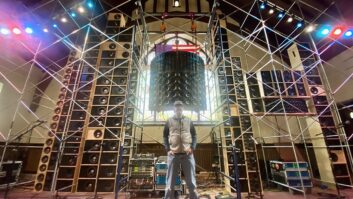One of my favorite things to do when tracking or mixing is to use parallel chains of gear, creating parallel chains of sound. Simply put, a parallel chain is a copy of a single track, or group of tracks, that is processed and then mixed back in with the original tracks. When I say “copy,” that can mean a send from a single track to an Aux input, a second physical copy of a track, or a group of tracks (like toms, for instance) sent across a bus, or buses, then blended to a new stereo Aux input. It sounds simple, and it is, but the magic happens when you process your copy and figure out how it works best with the original.
I remember the first time I heard a great drum recording. I had the chance to solo all the mics, some of which were dry and unimpressive. But the whole picture, when all the inputs worked together, was stunning. The kick and toms had a big fat bottom end with beautiful attacks on the stick hits, and the snare was a rifle shot. The cymbals were crisp without being strident and were so present it sounded like I was sitting on the drum throne playing the kit—it was both intimate and stadium-like at the same time. The “secret” to this great track was parallel compression and EQ. Once I “got it,” I started collecting parallel tips from every engineer I worked with.
BPT (Before Pro Tools), when I was an assistant engineer, Mick Guzauski had me mult a dull-sounding snare to an adjacent track, which he compressed flat with a dbx 160 and proceeded to boost enough 3 kHz that it ripped your face off. But when it was tucked in under the dullard, it was just the ticket. (Of course, now you’d use Sonnox TransMod, elysia nvelope, or Slate’s FG-Bomber plug- in.) John McBride runs two parallel drum chains, one stereo from the multitrack buses on the console where he sends the kick, snare, toms and overheads to a Fairchild, plus individual kick and snare parallel bus sends to both sides of a BBE Sonic Maximizer set appropriately for each feed. Once they all come back to the console and are blended with the direct mic feeds, it makes the drums bigger than life.
You can use parallel chains on vocals, guitars, drums, handclaps, percussion and more. I’ve been using what I call a Kit Close mic that I like to grunge up with a guitar pedal or some other overdriver. The new Chandler REDD mic has been working admirably in this regard; I place just over the kick drum facing the snare in omni. The mic has its own preamp, which I set in Drive mode for a gritty edge that I bring out further with an 1176 Blue Stripe compressor. Since it’s line-level out of the mic, I also mult the clean feed to a separate track in case I want to re-treat it later—a parallel chain from a single microphone.
For rock vocals I’ll have the vocalist sing into two mics, a live parallel chain. One mic is a standard SM7 going directly through a preamp and compressor into Pro Tools. The second mic, placed right next to the other, is a Placid Audio Copperphone or Shure Green Bullet going into a guitar amp, which is miked and sent to a second track.
Another reamping trick is one that I borrowed from Jacquire King and altered a bit. It all starts with a “trash” mic, something you place on the floor under a snare drum; this goes to a preamp of your choice, then into a Radial EXTC or other re-amp box. This goes into a Boss NS-1 Noise Suppressor then an amp head such as a Sovtek or the like. From there, the speaker out goes to an SE Electronics RNDI. The Thru from the RNDI goes to a ceramic 8-ohm resistor to take the load and the XLR goes right to Pro Tools. (The RNDI needs P48 so you’ll need an ATUS box or something else like it at the output.) Once you set it up and start tweaking the amp, it’s stunningly distorted and ugly, but under the rest of the track it puts the kit right up in your face.
I’ve recently been binge watching videos at PureMix, most nota- bly from Andrew Scheps, who has a great tutorial on how his mix template works, especially in reference to parallel chains. This blew my mind, and I’ve been trying most of his tips both inside and outside the box on mix and tracking sessions. Andrew uses a Kick-Snare crush, a parallel send to a Fatso plug-in, a parallel drum “dirt” bus, sometimes a stereo Tom Crush bus, and a separate Drum Crush that he EQs and compresses appropriately to manage the cymbals next to the K-S and Tom chains. His ears are incredible and he is a natural-born teacher. In other videos, he goes over the settings of the plug-ins in the template and how the chains effect the overall sound of the kit, guitars, vocals and more. Watch his Green Day Bang Bang mix video—it will change your life.
I’m venturing into new parallel territory this next week. FedEx just dropped off a pair of the new Maag Magnum K-Compressors that I’m going to use on a drum crush bus where I’ll send the hi-hat, and OHs so I can parallel crush the cymbals. The K has two compressors, one full-featured with threshold, sidechian and attack/release, and a second K-Comp crushing just at 3 kHz. Next, there’s a parallel, boost-only, 2-band EQ, plus a soft limiter at the output. It’s stuff like this that keeps me up at night thinking how I can use it.
Isn’t audio gear grand!!







